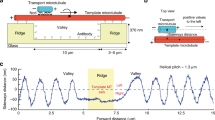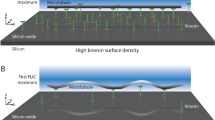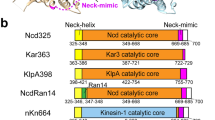Abstract
Kinesin motors power many motile processes by converting ATP energy into unidirectional motion along microtubules. The force-generating and enzymatic properties of conventional kinesin have been extensively studied; however, the structural basis of movement is unknown. Here we have detected and visualized a large conformational change of a ∼15-amino-acid region (the neck linker) in kinesin using electron paramagnetic resonance, fluorescence resonance energy transfer, pre-steady state kinetics and cryo-electron microscopy. This region becomes immobilized and extended towards the microtubule ‘plus’ end when kinesin binds microtubules and ATP, and reverts to a more mobile conformation when γ-phosphate is released after nucleotide hydrolysis. This conformational change explains both the direction of kinesin motion and processive movement by the kinesin dimer.
This is a preview of subscription content, access via your institution
Access options
Subscribe to this journal
Receive 51 print issues and online access
$199.00 per year
only $3.90 per issue
Buy this article
- Purchase on Springer Link
- Instant access to full article PDF
Prices may be subject to local taxes which are calculated during checkout





Similar content being viewed by others
References
Goldstein,L. S. B. & Philp,A. V. The road less traveled: emerging principles of kinesin motor utilization. Annu. Rev. Cell Dev. Biol. 15, 141–183 (1999).
Vale,R. D. & Fletterick,R. J. The design plan of kinesin motors. Annu. Rev. Cell Dev. Biol. 13, 745–777 (1997).
Kull,F. J., Sablin,E. P., Lau,R., Fletterick,R. J. & Vale,R. D. Crystal structure of the kinesin motor domain reveals a structural similarity to myosin. Nature 380, 550–555 (1996).
Sablin,E. P., Kull,F. J., Cooke,R., Vale,R. D. & Fletterick,R. J. Crystal structure of the motor domain of the kinesin-related motor ncd. Nature 380, 555–559 (1996).
Howard,J., Hudspeth,A. J. & Vale,R. D. Movement of microtubules by single kinesin molecules. Nature 342, 154–158 (1989).
Svoboda,K., Schmidt,C. F., Schnapp,B. J. & Block,S. M. Direct observation of kinesin stepping by optical trapping interferometry. Nature 365, 721–727 (1993).
Berliner,E., Young,E. C., Anderson,K., Mahtani,H. & Gelles,J. Failure of a single-headed kinesin to track parallel to microtubule protofilaments. Nature 373, 718–721 (1995).
Vale,R. D. et al. Direct observation of single kinesin molecules moving along microtubules. Nature 380, 451–453 (1996).
Hancock,W. O. & Howard,J. Processivity of the motor protein kinesin requires two heads. J. Cell Biol. 140, 1395–1405 (1998).
Hackney,D. D. Evidence for alternating head catalysis by kinesin during microtubule-stimulated ATP hydrolysis. Proc. Natl Acad. Sci. USA 91, 6865–6869 (1994).
Ma,Y.-Z. & Taylor,E. W. Interacting head mechanism of microtubule-kinesin ATPase. J. Biol. Chem. 272, 724–730 (1997).
Gilbert,S. P., Moyer,M. L. & Johnson,K. A. Alternating site mechanism of the kinesin ATPase. Biochemistry 37, 792–799 (1998).
Rayment,I. et al. Structure of the actin–myosin complex and its implications for muscle contraction. Science 261, 58–65 (1993).
Dominguez,R., Freyzon,Y., Trybus,K. M. & Cohen,C. Crystal structure of a vertebrate smooth muscle myosin motor domain and its complex with the essential light chain: visualization of the pre-power stroke state. Cell 94, 559–571 (1998).
Corrie,J. E. T. et al. Dynamic measurements of myosin light-chain-domain tilt and twist in muscle contraction. Nature 400, 425–430 (1999).
Suzuki,Y., Yasunaga,T., Ohkura,R., Wakabayashi,T. & Sutoh,K. Swing of the lever arm of a myosin motor at the isomerization and phosphate-release steps. Nature 396, 380–383 (1998).
Case,R. B., Pierce,D. W., Hom-Booher,N., Hart,C. L. & Vale,R. D. The directional preference of kinesin motors is specified by an element outside of the motor catalytic domain. Cell 90, 959–966 (1997).
Henningsen,U. & Schliwa,M. Reversal in the direction of movement of a molecular motor. Nature 389, 93–96 (1997).
Endow,S. A. & Waligora,K. W. Determinants of kinesin motor polarity. Science 281, 1200–1202 (1998).
Arnal,I. & Wade,R. H. Nucleotide-dependent conformation of the kinesin dimer interacting with microtubules. Structure 1998, 33–38 (1998).
Hirose,K., Lowe,J., Alonso,M., Cross,R. A. & Amos,L. A. Congruent docking of dimeric kinesin and ncd into three-dimensional electron cryomicroscopy maps of microtubule-motor ADP complexes. Mol. Biol. Cell 10, 2063–2074 (1999).
Hirose,K., Lockhart,A., Cross,R. A. & Amos,L. A. Three-dimensional cryoelectron microscopy of dimeric kinesin and ncd motor domains on microtubules. Proc. Natl Acad. Sci. USA 93, 9539–9544 (1996).
Mchaourab,H. S., Lietzow,M. A., Hideg,K. & Hubbell,W. L. Motion of spin-labeled side chains in T4 lysozyme. Correlation with protein structure and dynamics. Biochemistry 35, 7692–7704 (1996).
Naber,N., Cooke,R. & Pate,E. Binding of ncd to microtubules induces a conformational change near the junction of the motor domain with the neck. Biochemistry 36, 9681–9689 (1997).
Sack,S. et al. X-ray structure of motor and neck domains from rat brain kinesin. Biochemistry 36, 16155–16165 (1997).
Kozielski,F. et al. The crystal structure of dimeric kinesin and implications for microtubule-dependent motility. Cell 91, 985–994 (1997).
Stone,D. B., Hjelm,R. P. Jr & Mendelson,R. A. Solution structures of dimeric kinesin and Ncd motors. Biochemistry 38, 4938–4947 (1999).
Marx,A. et al. Conformations of kinesin: solution versus crystal structures and interactions with microtubules. Eur. Biophys. J. 27, 455–465 (1998).
Fisher,A. J. et al. X-ray structures of the myosin motor domain of Dictyostelium discoideum complexed with MgADP.BeFx and MgADP.AlF-4. Biochemistry 34, 8960–8972 (1995).
Houdusse,A., Kalabokis,V. N., Himmel,D., Szent-Gyorgyi,A. G. & Cohen,C. Atomic structure of scallop myosin subfragment S1 complexed with MgADP: a novel conformation of the myosin head. Cell 97, 459–470 (1999).
Sosa,H. et al. A model for the microtubule-ncd motor protein complex obtained by cryo-electron microscopy and image analysis. Cell 90, 217–224 (1997).
Kozielski,F., Arnal,I. & Wade,R. H. A model of the microtubule-kinesin complex based upon electron cryomicroscopy and X-ray crystallography. Curr. Biol. 8, 191–198 (1998).
Hoenger,A. et al. Image reconstructions of microtubules decorated with monomeric and dimeric kinesins: comparison with X-ray crystallography. Curr. Biol. 8, 191–198 (1998).
Ma,Y. Z. & Taylor,E. W. Mechanism of microtubule kinesin ATPase. Biochemistry 34, 13242–13251 (1995).
Romberg,L. & Vale,R. D. Chemomechanical cycle of kinesin differs from that of myosin. Nature 361, 168–170 (1993).
Romberg,L., Pierce,D. W. & Vale,R. D. Role of the kinesin neck region in processive microtubule-based motility. J. Cell. Biol. 140, 1407–1416 (1998).
Jiang,W. & Hackney,D. D. Monomeric kinesin head domains hydrolyze multiple ATP molecules before release from a microtubule. J. Biol. Chem. 272, 5616–5621 (1997).
Moyer,M. L., Gilbert,S. P. & Johnson,K. A. Pathway of ATP hydrolysis by monomeric and dimeric kinesin. Biochemistry 37, 800–813 (1998).
Visscher,K., Schnitzer,M. J. & Block,S. M. Single kinesin molecules studied with a molecular force clamp. Nature 400, 184–189 (1999).
Coppin,C. M., Pierce,D. W., Hsu,L. & Vale,R. D. The load dependence of kinesin's mechanical cycle. Proc. Natl Acad. Sci. USA 94, 8539–8544 (1997).
Thomas,D. D., Ramachandran,S., Roopnarine,O., Hayden,D. W. & Ostap,E. M. The mechanism of force generation in myosin: a disordered-to-order transition, coupled to internal structural changes. Biophys. J. 68 (suppl.), 135s–141s (1995).
Wang,H. & Oster,G. Energy transduction in the F1 motor of the ATP synthase. Nature 396, 279–282 (1998).
Al-Shawi,M. & Nakamoto,R. Mechanism of energy coupling in the FoF1-ATP synthase: the uncoupling mutant, γM23K, disrupts the use of binding energy to drive catalysis. Biochemistry 36, 12954–12960 (1997).
Weissman,J. S., Rye,H. S., Fenton,W. A., Beechem,J. M. & Horwich,A. L. Characterization of the active intermediate of a GroEL–GroES-mediated protein folding reaction. Cell 84, 481–490 (1996).
Fujiwara,S., Kull,F. J., Sablin,E. P., Stone,D. B. & Mendelson,R. A. The shapes of the motor domains of two oppositely directed microtubule motors, ncd and kinesin: a neutron scattering study. Biophys. J. 69, 1563–1568 (1995).
Woehlke,G. et al. Microtubule interaction site of the kinesin motor. Cell 90, 207–216 (1997).
Safer,D. Undecagold cluster labeling of proteins at reactive cystein residues. J. Struct. Biol. 127, 371–374 (1999).
Van Der Meer,B. W., Coker,G. & Chen,S.-Y. S. Resonance Energy Transfer: Theory and Data (VCH, New York, 1994).
dos Remedios,C. G. & Moens,P. D. Fluorescence resonance energy transfer spectroscopy is a reliable “ruler” for measuring structural changes in proteins. Dispelling the problem of the unknown orientation factor. J. Struct. Biol. 115, 175–185 (1995).
Barnett, V. A., Fajer,P., Polnaszek,C. F. & Thomas,D. D. High resolution detection of muscle crossbridge orientation by EPR. Biophys. J. 49, 144–147 (1986).
Acknowledgements
We thank L. Sweeney for encouragement; A. Ruby for assistance with protein preparations; B. Sheehan for computing and image processing; and M. Tomishige for examining the processivity of cys-light K560–GFP. We thank R. Case and K. Thorn for comments on the manuscript. This work was supported, in part, by grants for the NIH (R.A.M., E.W.T., R.C. and R.D.V.), and the NSF (B.O.C.). S.R. is supported by the UCSF Graduate Group in Biophysics.
Author information
Authors and Affiliations
Corresponding author
Rights and permissions
About this article
Cite this article
Rice, S., Lin, A., Safer, D. et al. A structural change in the kinesin motor protein that drives motility. Nature 402, 778–784 (1999). https://doi.org/10.1038/45483
Received:
Accepted:
Issue Date:
DOI: https://doi.org/10.1038/45483
This article is cited by
-
Microtubule damage shapes the acetylation gradient
Nature Communications (2024)
-
Confined-microtubule assembly shapes three-dimensional cell wall structures in xylem vessels
Nature Communications (2023)
-
Magic-angle-spinning NMR structure of the kinesin-1 motor domain assembled with microtubules reveals the elusive neck linker orientation
Nature Communications (2022)
-
Mechanochemical tuning of a kinesin motor essential for malaria parasite transmission
Nature Communications (2022)
-
Anchoring geometry is a significant factor in determining the direction of kinesin-14 motility on microtubules
Scientific Reports (2022)
Comments
By submitting a comment you agree to abide by our Terms and Community Guidelines. If you find something abusive or that does not comply with our terms or guidelines please flag it as inappropriate.



